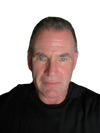Wide Awake.
If we want our lives to be an exciting adventure, we should live out of our imagination. Not out of our memory.

Early in my flight training, I had a short solo cross-country flight from Houston to College Station of 88 miles. I would arrive with a couple of simple compass headings, a few landmarks, and presto. With only a couple of hours of pilot in command (PIC) time, I felt the information overload and the burden of command. No flight instructor to lean on. Navigation for a VFR (visual flight rules) flight requires that I use landmarks as references or waypoints in transit. Ten minutes into my flight, I was disoriented and lost. Landmarks on the ground didn’t jive with my route planning. My body surged with panic, but having been in a dozen life-and-death situations, I turned fear into creative fuel.
My quick and dirty solution was to ensure I had the College Station VOR (very high-frequency omnidirectional range) dialed in. VORs look like a huge bicycle wheel laid flat on its side. Each ‘’poke’ of the wheel is an antenna that broadcasts a radio beam or ‘radial.’ Pilots can follow these radials to navigate from distances up to 350 nautical miles. And I dropped my altitude to a thousand feet to fly the road system, specifically highway 6, to Easterwood Field. I could read the road signs from 1,000 feet. I arrived a few minutes late and embarrassed but safe and sound. Where had I failed? What had I missed in my preparation?
Several unanticipated and external challenges had pushed me off course. My mistake lay in trusting a fluid situation would follow a script. That was my blind spot in flight preparation and piloting that day. No plan is perfect, and no flight stays on script. Imperfections exist in every flight that seeks to harness mother nature’s wind. As the pilot in command, my job is to master imperfections guaranteed to arise.
For my next flight, I doubled my route preparation efforts and gave myself plans B and C as alternatives for mastering the imperfections. Planes don’t have fender benders. Pilot errors result in lives lost. After that day, my reality was forever changed. I was wide awake. My embarrassing lesson that day saved my life countless times. I was wide awake to the incredible joy of constant and neverending adjustments in flight. No two takeoffs, flights, and landings are ever the same, and I relished the art of defying gravity.
Many times, we assume that our thoughts are reality. Our values are the clearest. Our beliefs are gospel. Our way of thinking is the only possible way. We believe that our ideas are rational and those of the others inconsistent. We emotionally invest in these solid and immovable “certainties.” Our “rock-solid" certainties might prove to be psychological blind spots. The consequences can be tragic.
The lyrics to a Katy Perry song (see below) reminded me of a blurred reality or blind spots. Many of us have been blindsided by a train we did not see coming. Push play and enjoy Ms. Perry’s song as you read on. Listen closely to the lyrics.
I am wide awake.
Yeah, I was in the dark
I was falling hard
With an open heart (I'm wide awake)
How did I read the stars so wrong? (I'm wide awake)
And now it's clear to me
That everything you see
Ain't always what it seems (I'm wide awake)
Yeah, I was dreaming for so long
I wish I knew then, what I know now
Wouldn't dive in, wouldn't bow down
Gravity hurts, you made it so sweet
'Til I woke up on, on the concrete
Falling from cloud nine
Crashing from the high
I'm letting go tonight
Yeah, I'm falling from cloud nine
The last couple of lines describes our sudden realization that we see a situation or a person in a more naked and truthful light. Reality bursts into our field of vision like a fireworks display.
I am trying to hold on (I’m wide awake)
God knows that I tried
Seeing the bright side (I’m wide awake)
I’m not blind anymore
I’m wide awake
In 2002, a group of social psychologists from Princeton University coined the term bias blind spots. We cannot recognize the impact of our biases and limitations on our judgment, behavior, and decisions. Although we do not have problems recognizing them in others, it indicates that it is not a matter of ignorance but instead a motivated ignorance to protect the image we have formed of ourselves and others.

The problem with psychological blind spots is that we assume our biases as trustworthy, thinking that we are immune to them, so we deceive ourselves. Labeling others as biased, while we believe we are objective and impartial, is an illusion. Everything we deny about ourselves weakens us because it prevents us from growing, making us assume a more immature and dysfunctional posture.
The first source of blind spots is “The Halo Effect.” ” Our positive evaluations of someone in our lives bleed over into judgments about a person’s specific traits. They can do no wrong, which is absurd. Everyone has flaws. Some are more grievous and harmful than others.
The second source is Cognitive Dissonance. This is how we perceive the surrounding world and how we explain it to ourselves. If we lie to ourselves and break inner promises, the appearance of blind spots is somewhat likely.
The third source is prejudice and the inability to think critically. Our past intrudes on our present. Our experience does not lend clarity to a new situation because we can’t let go.
The fourth source of blind spots is an unwillingness to take responsibility for our actions. When we refuse to take responsibility, we can not control any situation. The blame game and labels are useless, leading to more blind spots. We are not a cookie made with a cookie cutter. Critically assessing failures and taking accountability for misjudgments allows for course correction.
The fifth source is our belief in our intuition. “many people naturally believe they are good ‘intuitive psychologists,’’ thinking it is relatively easy to predict other people’s attitudes and behaviors. We rely on our intuition instead of reasoning and tapping our experience, which is the leading cause of failures and blind spots in our thinking. Esgate, Groome, and Baker (2004)
The last source is the necessity of conforming to the norm. We tend to follow the crowd or herd. We copy each other’s manners, ways of thinking, and even the words we use daily. That conformity invades and clouds our thinking process.
We all have blind spots. The solution to blind spots is simple. Trust your preparation, experience, and gut, but verify your process. On 1,545 mile trip from Houston, Texas, to Los Angeles, California, who in their right mind would ignore the road signs and only use a map once? Even while traveling exclusively on Interstate 10, a responsible driver constantly checks direction and progress with their map and reads the road signs.
What signs did you ignore the last time a train blindsided you?
Until next time. Travel safe.
Endnotes
Esgate, A., Groome, D., Baker, K., Heathcote, D., Kemp, R., Maguire, M., et al. (2004). n Introduction to Applied Cognitive Psychology, England: Psychology Press.
Miller, E. M. (2005). Studying the Meaning of Giftedness: Inspiration from the Field of Cognitive Psychology. Roeper Review, 27(3), 172

